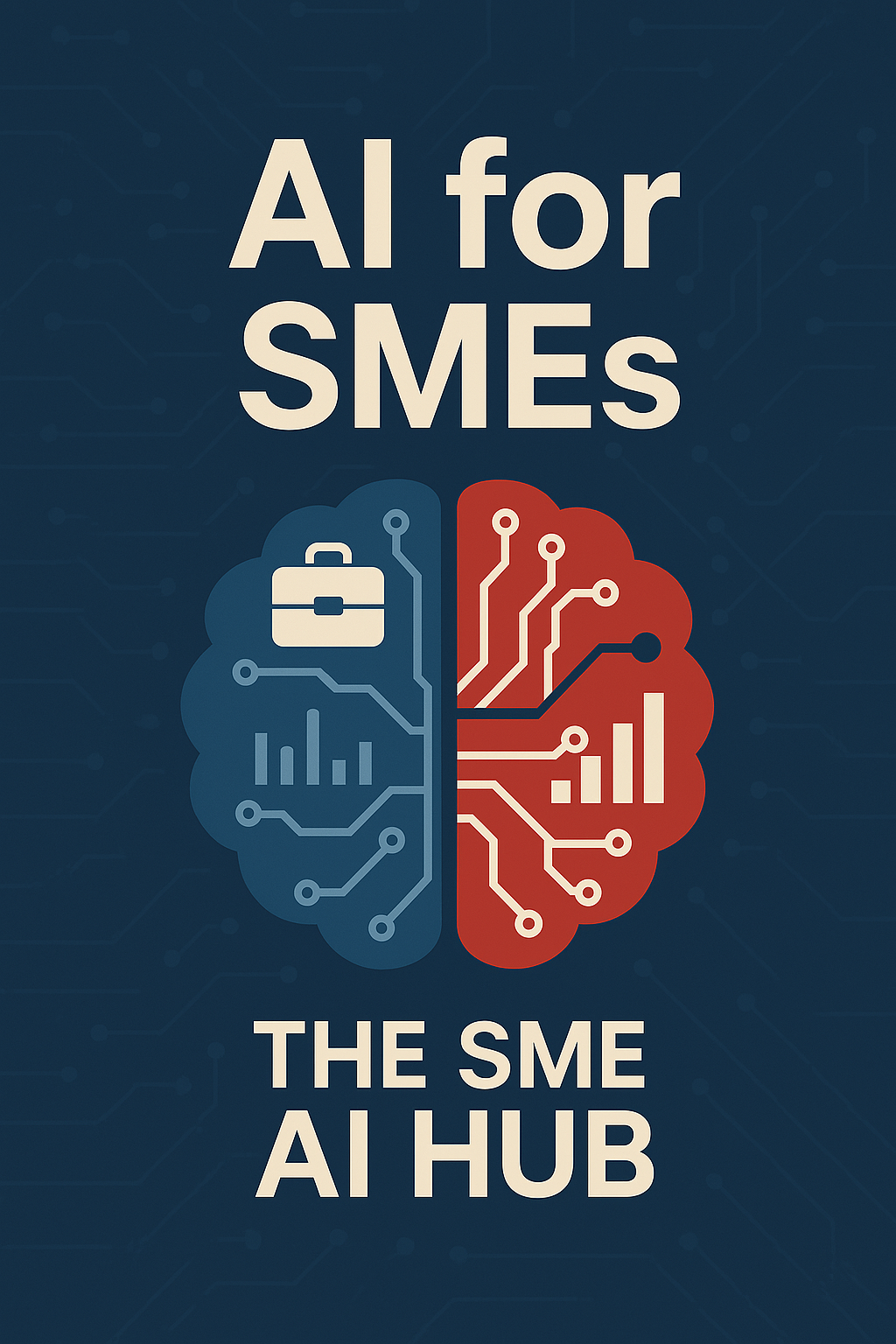Cutting Through the AI Hype and Headlines: What SMEs Really Need to Know

If you’ve attended any of the webinars I’ve been involved in, you’ll know I often talk about Hype and Headlines. The last few weeks have been full of exactly that in the AI world.
Three stories in particular have dominated discussions:
- A recent MIT Nanda report suggested that despite $30–40 billion in enterprise investment into Generative AI, 95% of organisations are seeing zero return.
- Sam Altman, CEO of OpenAI, suggested that AI is in a “bubble” — a phrase that instantly brings to mind the dot-com crash of the late 1990s.
- The underwhelming reception of OpenAI’s GPT‑5 launch, which delivered modest updates rather than the dramatic leap many expected — a reminder that hype often runs ahead of reality.
All three headlines have triggered speculation about whether AI is overhyped, whether progress is slowing, and what it all means for businesses.
In this month’s blog, we’re going to unpack these headlines, cut through the noise, and look at what they mean for SMEs in practical terms.

📊 What the MIT Nanda Report Really Said
The MIT Nanda research doesn’t say “AI is useless.” Far from it. Instead, it highlights a simple but important truth:
👉 Most businesses are chasing AI hype rather than solving real problems.
Too many AI projects start with the mindset: “We should be using AI” rather than “What problem can AI help us solve?”
This leads to:
- Expensive pilots with no follow-through.
- Half-finished tools that never make it into daily operations.
- Projects that showcase potential but fail to deliver measurable results.
💡 For SMEs, the lesson is clear: don’t adopt AI for the sake of it. Adopt AI with purpose.
Start from your business challenges — wasted time, manual bottlenecks, costly admin — and then ask how AI could help. That’s where real return on investment lives.
⚖️ A Note of Critique on the MIT Nanda Report
While the findings are headline-grabbing, it’s important to take them with caution. The report gives little detail about the specific companies interviewed or the industries they represent. Without that context, it’s hard to know whether the sample reflects the wider market or just a narrow slice of it.
Another important point: is the sample representative enough to support such a sweeping conclusion as the 'GenAI Divide'? The research is based on 52 organisations for interviews and 153 senior leaders for surveys. You could question whether this sample is large or diverse enough to represent the entire enterprise landscape — a limitation the authors themselves note.
Moreover, some have noted that the report feels less like neutral research and more like a promotional piece for Nanda AI Agents — the company’s own AI project. That doesn’t invalidate the insights, but it does mean SMEs should read the results critically, recognising that the framing may be designed to support Nanda’s own project and positioning.
The takeaway? Don’t accept big AI Headlines at face value — positive or negative. Always look at the detail behind them.

💭 Is AI Really in a Bubble?
When Sam Altman says AI is in a “bubble,” he isn’t predicting the end of AI. Instead, he’s pointing out a number of realities:
- Mr Altman noted that some AI startups are receiving funding at "insane" valuations, indicating a lack of rational behavior from some investors.
- Despite the bubble-like conditions, Altman believes that AI's ultimate societal and economic value will be enormous.
- Expectations are sky-high — with some people assuming AI will replace entire jobs or industries almost overnight, which is unrealistic.
- As a result, some startups and tools will inevitably fail because they don’t fix everyday business problems like saving time, cutting costs, or improving customer service — the things SMEs care most about.
📌 History shows this is a familiar pattern. The dot-com boom of the 1990s was full of hype, and many companies did collapse, but the underlying technology (the internet) fundamentally changed the world. The key takeaway isn’t that AI is destined for the same crash, but that hype cycles often exaggerate short-term disruption while the underlying technology continues to evolve and deliver lasting value.
A bubble may burst around the hype, but the underlying technology continues to mature and grow.
⏸️ Is AI Slowing Down?
Some pointed to the underwhelming reception of GPT‑5 and falling tech stock prices (August 2025) as signs AI might be slowing. In truth, AI is not stalling — it’s shifting from flashy launches to steady, practical improvements.
Instead of big “wow” moments, progress now looks like better accuracy, smoother integration into business tools, and more reliable models. For SMEs, that’s a good thing: it means the tools are more stable, affordable, and genuinely useful.
So while the headlines may feel less dramatic, AI is maturing, not slowing down — creating safer, more valuable opportunities for small businesses to adopt it without getting caught up in hype.
🚀 What This Means for SMEs
So, should SMEs hold back until things “settle down”? Absolutely not.
Here’s why:
- AI is here to stay. The noise may be distracting, but the technology itself is not going anywhere.
- Practical adopters will win. The businesses that quietly find useful, small ways to apply AI will save money, build capability, and get ahead of competitors.
- Small steps beat big leaps. You don’t need a million-pound R&D budget. You just need to solve one business problem at a time.
The bubble talk is about investment hype. For SMEs, the opportunity is in practical application.
🛠️ Practical AI Steps for SMEs
Here are five ways SMEs can cut through the hype and make AI work for them today:
- Start with pain points 🔍 – Identify where your business is losing time or money. Is invoicing slow? Is customer follow-up inconsistent? These are great starting points.
- Test with existing tools 🧰 – AI is already built into platforms you use: Microsoft 365 Copilot, Google Workspace, accounting software, CRMs. You might not need a new tool at all. Check their roadmaps to gain sight of future product feature releases.
- Explore new AI platforms 🌐 – Tools like ChatGPT and Google Gemini are evolving rapidly and can handle tasks such as drafting documents, summarising reports, deep research or answering customer queries. Experimenting with them helps you understand their strengths and limitations before making bigger commitments.
- Run small pilots 🧪 – Trial AI in one process (for example, automating invoice data entry or generating draft marketing content). Measure results, then decide whether to scale.
- Focus on ROI, not novelty 💷 – Ask: “Does this save money, time, or effort?” If the answer is no, it’s probably not for us right now.
- Build AI awareness in your team 👥 – AI isn’t just for management. Train staff to use it responsibly and effectively so adoption sticks. Subscribe to my free blog post.
🔮 Final Word: Hype vs Reality
The MIT Nanda report and Sam Altman’s “bubble” warning both point to the same thing: beware of hype.
But hype doesn’t mean failure. AI is evolving and will continue to reshape business. The challenge for SMEs isn’t whether AI is “real” — it’s how to make AI real for your business.
👉 Start small. Stay practical. Focus on solving real business problems, not chasing headlines. That’s how SMEs can turn today’s “AI bubble” into tomorrow’s opportunity.
✅ Your Next Step
Think of one pain point or bottleneck in your business that feels slow, repetitive, or costly. Could AI streamline it? That’s where your AI journey begins.
👉 Want more guidance? Subscribe for free at www.aiforsmes.co.uk for practical insights and resources.
👉 Or join our upcoming webinar: Prompting Made Simple – Unlocking AI for SMEs.
Both are great ways to continue your AI journey and cut through the hype with clear, actionable advice.

